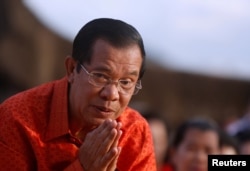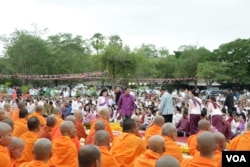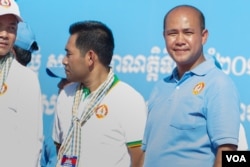In front of the largest religious monument on Earth, the world's longest-ruling prime minister — Cambodia's Hun Sen — prayed for peace and happiness in front of 5,000 monks Sunday.
As loudspeakers invoked the kings of Cambodia's once glorious empire, a grandiose spectacle full of royal symbolism unfolded in front of Angkor Wat to mark a new chapter in the country's political history.
With his opponents from the now dissolved Cambodia National Rescue Party vanquished, Hun Sen basked in the glory of this spectacular extravaganza — captured by a team of drones broadcasting live onto giant screens.
It was a scene that marked something of a departure from the cult of personality Hun Sen traditionally has cultivated as a self-made rebel rather than an entitled member of the ruling class, observers told VOA.
Political scientist Astrid Noren-Nilsson, who authored Cambodia's Second Kingdom: Nation, Imagination, and Democracy, said in an email that any claim to legitimate power vested in tradition in Cambodia inevitably fell back on the historical model of kingship.
"Still, there appears to be a shift in how Hun Sen relates his brand of leadership to kingship. Until now, he has mainly made himself known as Sdech Kan — a rebel on the throne who uproots the genealogical line of the Angkorean kings," she said.
The tale of Sdech Kan — a 16th-century peasant who rose to usurp the throne before he was overthrown and beheaded — is a fixation of the premier's and recently was immortalized in the most expensive Cambodian film ever made.
"The recent ceremony suggests a shift to loudly project continuity with the Angkorean kings. I believe that this duality is here to stay, and that the second theme will become increasingly prominent."
A pamphlet distributed at the ceremony drew parallels between the ceremony and the struggle of Jayavarman II, who united the upper and lower kingdoms of Chenla, founded the Khmer empire and deified the monarchy after rising to the throne in the late 7th century.
Peace prayer ceremony
Minister of Culture Phoeung Sakona said the same ceremony had been employed by kings of yesteryear to celebrate the sacrifices of great national heroes, but she stressed it could only be held during peace.
"Once we got independence from French, King Norodom [Sihanouk] also celebrated the praying [ceremony]," she said.
"When three provinces were given back to Cambodia [from Thailand], King Sisowath also celebrated the same praying, so it is not about the question of what is the motive behind this celebration."
After crushing his political opponents during a wave of political violence in 1997, Hun Sen held the same peace prayer ceremony at Angkor Wat in the name of national reconciliation.
Noren-Nilsson said the difference that time was Hun Sen's defeated political opponents — then Sam Rainsy and Prince Norodom Ranariddh — actually were invited to make peace.
On Sunday, not only were opposition members absent but, despite the overtones of divine authority, Cambodia's actual king, Norodom Sihamoni, and Queen Mother Norodom Monineath were nowhere to be seen.
Neither Kong Sam Ol, Minister for the Royal Palace, nor Oum Daravuddh, an adviser to the royal cabinet, could be reached to explain the absence and sources close to the royal family declined to speak on the record.
Family roles
Also apparently absent were all of Hun Sen's progeny, except for a modestly dressed Hun Many, the youngest of Hun Sen's three sons, who was highly visible — greeting an ensemble of dignitaries dominated by party officials and ministers.
Political Analyst Ou Virak said he believed Hun Sen was likely looking to legitimize an imminent succession in the eyes of both his party and the Cambodian people.
"That change will take place. That generation shift to the next leadership who were actually born after the war days — that's going to be very interesting to see. It will take, my prediction is it will take place in the next five years," he said.
Though Hun Sen's eldest son, Hun Maneth, had long been considered the "chosen one," Virak suggested the premier might be leaning toward pushing Many — already a parliamentarian — out as the political face of his dynasty.
Maneth, who occupies senior positions in the Royal Cambodian Armed Forces, could then help retain tight control over the real base of power while his daughter Hun Mana solidified the economic foundations through her powerful business holdings, he said.
Many, 35, has significantly increased his public engagement in his role as head of the ruling party's youth association in recent years while cultivating a positive public image through his naturally friendly temperament.
Noren-Nilsson said she also believed Many's visibility at the event gave "one more indication that he might be groomed to succeed his father."
"In this context, it is noteworthy that the Ribbon ceremony [pithi ambas chang dai] was held, a blessing ceremony normally held at weddings for the prosperity of the couple — suggesting that the Angkor praying ceremony gave real centrality to the family and the bloodline of Hun Sen," she wrote.
Personal legacy
In terms of Hun Sen's own personal legacy though, Virak said if Hun Sen was seeking to deify himself he would struggle to convince a public who were only receptive to one figure of such heroic magnitude at a time.
"The biggest frustration for someone like Hun Sen would be that while he has led the country for many, many years, in terms of reverence, in terms of whether he's revered as much as the late King Sihanouk used to be, for example, I don't think that is something he will be able to achieve," Virak said.
If not, it won't be for a lack of trying.
About 10 kilometers north of Phnom Penh, a giant monument celebrating Hun Sen's "win-win" strategy of defeating or co-opting political opponents is being built by one of his richest beneficiaries.
The colossal structure has its own bas reliefs, just like Cambodia’s ancient temples, depicting the premiere’s life story from his own perspective, though the artists’ renditions show no sign of an ending yet.












